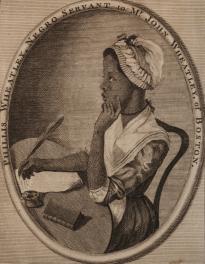Guided Readings: Using Primary and Secondary Sources: Slavery in the Founding Era
Primary and secondary sources can provide different kinds of information about the past. In the context of slavery, Phillis Wheatley is considered the most important figure of the eighteenth century. Two accounts of her experience having been carried to America and then enslaved appear below. Read each account, and then answer the questions that follow.
Reading 1
"On Being Brought from Africa to America"
’Twas mercy brought me from my Pagan land,
Taught my benighted soul to understand
That there’s a God, that there’s a Saviour too:
Once I redemption neither sought nor knew.
some view our sable race with scornful eye,
"Their colour is a diabolic die."
Remember, Christians, Negros, black as Cain,
May be refin’d , and join th’ angelic train.
Reading 2
Slavery in the Founding Era
"Phillis Wheatley, an American poet, is considered to be the first important black writer in the United States. Brought from Africa in 1761, she became a house slave for the Boston merchant John Wheatley and his wife Susanna, who, recognizing her intelligence and wit, educated her and encouraged her talent. Although Wheatley traveled to England where she was much admired and soon after obtained her freedom, she eventually died in poverty."
The first selection is "On Being Brought from Africa to America," by Phillis Wheatley, published in Poems on Various Subjects, Religious and Moral (1773). The second selection is from http://education.yahoo.com/reference/encyclopedia/entry/WheatlyP.
Questions for Discussion
- Which account is a primary source and which is a secondary source? How can you tell?
- Who was the audience for the primary source?
- Who is the audience for the secondary source?
- What information does the primary source give you that the secondary source does not?
- What information does the secondary source give you that the primary source does not?
- Name a primary source you have used recently.
- Name a secondary source you have used recently.
- Look at the engraving below. What further information does this picture tell you about Phillis Wheatley?
- Use her poem (the primary source document) to explain how Wheatley expresses both her gratitude for Christian salvation and her dislike of racial slavery. Cite specific phrases and lines to support your view.

